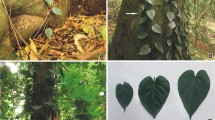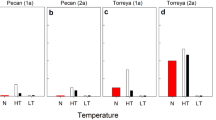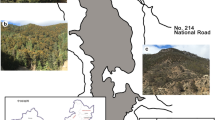Abstract
Pachypodium namaquanum (Nyley ex Harb.) Welw., an unusual arborescent stem succulent from the succulent karoo of the arid Richtersveld in north-western South Africa and adjacent Namibia, is characterized by a striking curvature of the terminal 20–60 cm of the trunk toward the north. This orientation displays the single terminal whorl of drought-deciduous leaves with their flat surface angled at a mean inclination of 55° from horizontal. Inclination of 50–60° was found in 65% of individuals sampled, and 85% were inclined between 45 and 65°. Northward azimuth was also quite regular, but varied slightly between populations. The fixed leaf orientation in P. namaquanum maximizes radiation absorption during the winter months when leaves are present. Leaves normally form in early fall (April) and abscise early in spring (October). Growing season conditions in the Richtersveld are relatively mild, with mean maximum temperature dropping only to 21.6°C in July, the coldest month of the year. Frosts are rare. By the fixed orientation of its leaf whorl, P. namaquanum is able to maintain nearly twice the midwinter radiation absorptance that it would have with horizontal orientation. Over an annual cycle the angled leaves receive more radiation than would horizontal leaves for each of the 6 months in which they are present on the plant. This increased winter irradiance is hypothesized to singificantly increase net primary production by concentrating growth activities in winter months and allowing the species to remain dormant during the hyperarid conditions of the hot summer months. Midwinter flowering from apical buds in P. namaquanum may also be aided by its stem orientation. The evolution of this characteristic pattern of winter growth phenology and nodding stem orientation may have come about because of low but relatively regular autumn precipitation and moderate winter temperatures. Slow and regular growth of P. namaquanum leads to long lifespans which may reach 300 years or more.
Similar content being viewed by others
References
Acocks JPH (1953) Veld types of South Africa. Mem Bot Surv S Afr 28:1–192
Cowling RM, Esler KJ, Midgley GF, Hönig MA (1994) Plant functional diversity, species diversity and climate in arid and semi-arid southern Africa. J Arid Environ 27:141–158
Dyer RA, Codd LE, Rycroft HB (1963) Flora of Southern Africa. Department of Agricultural Technical Series, Botenical Research Institute, Pretoria 26:283–287
Ehleringer J, Forseth I (1980) Solar tracking by plants. Science 210:1094–1098
Ehleringer JR, Werk KS (1981) Leaf absorptances of Mojave and Sonoran desert plants. Oecologia 49:366–370
Ehleringer J, Björkman O, Mooney HA (1976) Leaf pubescence: effect on absorptance and photosynthesis in a desert shrub. Science 192:376–377
Ehleringer J, Mooney HA, Gulmon SL, Rundel P (1980) Orientation and its consequences for Copiapoa (Cactaceae) in the Atacana Desert. Oecologia 46:63–67
Ezcurra E, Montaña C, Arizaga S (1991) Architecture, light interception and distribution of Larrea species in the Monte Desert, Argentina. Ecology 72:23–34
Ezcurra E, Arizago S, Valverde PL, Mourelle C, Flores-Martinez A (1992) Foliate movement and canopy architecture of Larrea tridentata (D.C.) Cov. in Mexican, deserts. Oecologia 92:893–89
Fons WL, Bruce HD, McMasters A (1960) Tables for estimating direct bean solar irradiance at 30°–46° latitude. USDA Forest Service. Pacific South-west Forest and Range Experimental Station, Berkeley
Forseth I, Ehleringer J (1980) Solar tracking response to drought in a desert annual. Oecologia 44:159–163
Franco-Vizcaino E, Goldstein G, Ting IP (1990) Comparative gas exchange of leaves and bark in three stem succulents of Baja California. Am J Bot 77:1272–1278
Hoffman MT, Cowling RM (1987) Plant physiognomy, phenology and demography. In: Cowling RM, Roux PW (eds) The karoo biome: a preliminary synthesis, part 2. Vegetation and history (South African National Scientific Programmes Report 142). Council for Scientific and Industrial Research, Pretoria, pp 1–24
Humphrey RR (1936) Growth habits of barrel cacti. Madronño 3:348–352
Humphrey RR (1974) The boojum and its home. University of Arizona Press. Tucson
Jacobsen H (1960) A handbook of succulent plants. Blandford Press, London
Jankowitz WJ (1979) The status of Pachypodium namaquanum in South West Africa, Aloe 17:41–46
Jürgens N (1986) Untersuchungen zur Ökologie sukkulentes Pflanzen des sudlichen Afrika. Mitt Inst Allg Bot Hamburg 21:129–365
Lewis DA, Nobel PS (1977) Thermal energy exchange model and water loss of a barrel cactus, Ferocactus acanthodes. Plant Physiol 60:609–616
List RJ (1968) Smithsonian meteorological tables. Smithsonian Institution Press, Washington D.C.
Marloth R (1932) Pachypodium. Flora S Afr 3:61–66
Mooney HA, Ehleringer J, Björkman O (1977a) The energy balance of leaves of the evergreen desert shrub Atriplex hymenelytra. Oecologia 29:301–310
Mooney HA, Troughton JH, Berry JA (1977b) Carbon isotope ratio measurements of succulent plants in southern Africa. Oecologia 30:295–305
Mozingo HN, Comanor PL (1975) Implications of the thermal response of Ferocactus acanthodes. Cact Succul J Suppl 1:22–28
Nagel JF (1962) Fog precipitation measurements on Africa's southwest coast. Notos 11:51–60
Neufeld HS, Meinzer FC, Wisdom CS, Sharifi MR, Rundel PR, Neufeld MS, Goldring Y, Cunningham GL (1988) Canopy architecture of Larrea tridentata (DC) Cov., a desert shrub: foliage orientation and direct beam radiation interception. Oecologia 75:54–60
Nilsen ET, Sharifi MR, Rundel PW, Forseth IN, Ehleringer JR (1990) Water relations of sterm succulent trees in north-central Baja California. Oecologia 82:299–303
Nobel PS (1980) Interception of photosynthetically active radiation by cacti of different morphology. Oecologia 45:160–166
Nobel PS (1982) Orientation of terminal cladodes of platyopuntias. Bot Gaz 143:219–224
Paterson W (1789) A narrative of four journeys into the country of the Hottentots and Caffraria in the years 1777, 1778, and 1779. Johnson, London
Puff C (1982) Taking another look at Pachypodium. Veld Flora 68:40–43
Rowley GD (1987) Caudiciform and pachycaul succulents. Strawberry, Mill Valley, California
Rundel PW, Gibson AC (1995) Ecological communities and processes in a Mojave Desert ecosystem: Rock Valley, Nevada. Cambridge University Press, Cambridge (in press)
Rutherford MC, Westfall RH (1986) Biomes of southern Africaan objective categorization. Mem Bot Surv S Afr 54:1–98
Vorster P, Vorster E (1973) The South African species of Pachypodium. Aloe 11:5–30
Weather Bureau (1986) Climate of South Africa: climate statistics up to 1984. Government Printer, Pretoria
Werk KS, Ehleringer J (1984) Non-random leaf orientation in Lactuca serriola L. Plant Cell Environ 7:81–87
Werk KS, Ehleringer J, Forseth IN, Cook CS (1983) Photosynthetic characteristics of Sonoran Desert winter annuals. Oecologia 59:101–105
Willert DJ von, Eller BM, Werger MJA, Brinckmann E, Ihlenfeldt H-D (1992) Life strategies of succulents in deserts. Cambridge University Press, Cambridge
Winter K (1979) δ13C values of some succulent plants from Madagascar. Oecologia 40:103–112
Author information
Authors and Affiliations
Rights and permissions
About this article
Cite this article
Rundel, P.W., Cowling, R.M., Esler, K.J. et al. Winter growth phenology and leaf orientation in Pachypodium namaquanum (Apocynaceae) in the succulent karoo of the Richtersveld, South Africa. Oecologia 101, 472–477 (1995). https://doi.org/10.1007/BF00329426
Received:
Accepted:
Issue Date:
DOI: https://doi.org/10.1007/BF00329426




